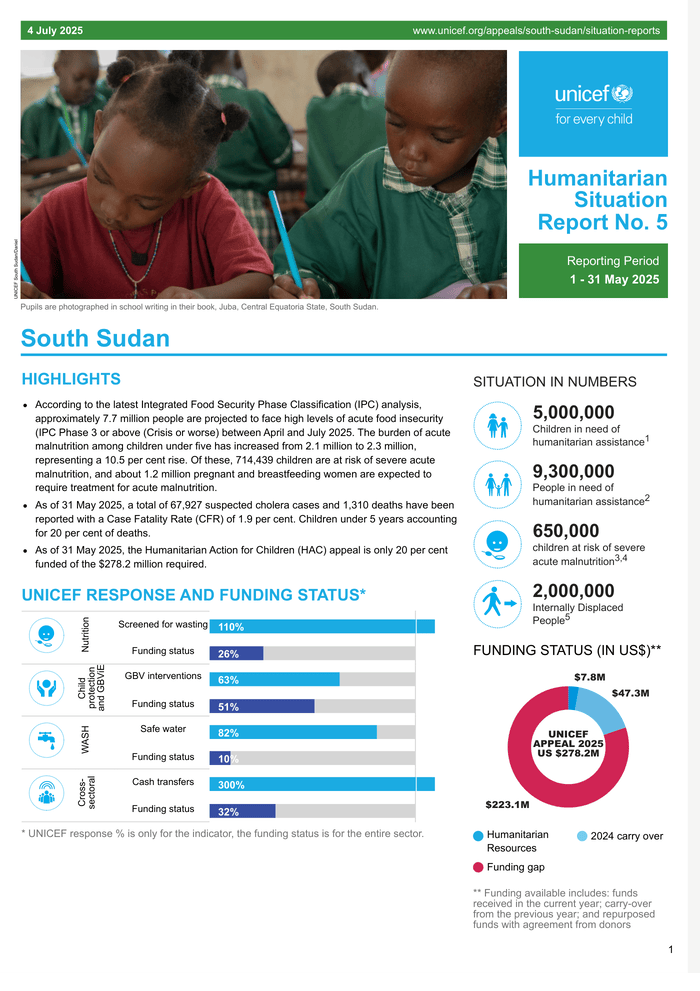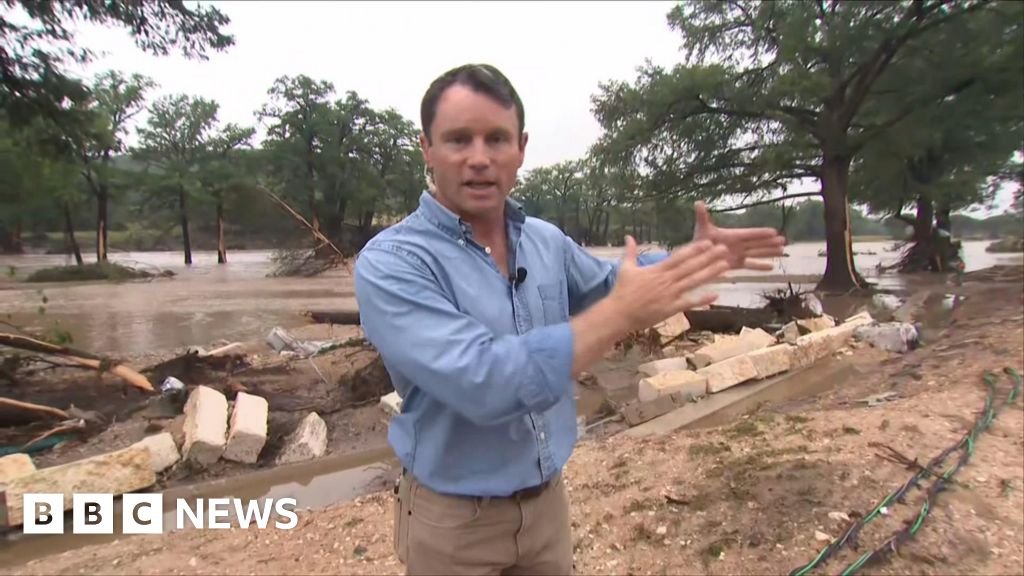HIGHLIGHTS
- According to the latest Integrated Food Security Phase Classification (IPC) analysis, approximately 7.7 million people are projected to face high levels of acute food insecurity (IPC Phase 3 or above (Crisis or worse) between April and July 2025. The burden of acute malnutrition among children under five has increased from 2.1 million to 2.3 million, representing a 10.5 per cent rise. Of these, 714,439 children are at risk of severe acute malnutrition, and about 1.2 million pregnant and breastfeeding women are expected to require treatment for acute malnutrition.
- As of 31 May 2025, a total of 67,927 suspected cholera cases and 1,310 deaths have been reported with a Case Fatality Rate (CFR) of 1.9 per cent. Children under 5 years accounting for 20 per cent of deaths.
- As of 31 May 2025, the Humanitarian Action for Children (HAC) appeal is only 20 per cent funded of the $278.2 million required.
[…]
SITUATION OVERVIEW AND HUMANITARIAN NEEDS
South Sudan continued to face a challenging humanitarian situation with escalating violence, displacement, disease outbreaks, and flooding risks. The food security and nutrition situation is sharply deteriorating. According to the latest Integrated Food Security Phase Classification (IPC) analysis, over half of the population (about 7.7 million people, or 57 per cent) facing high levels of acute food insecurity IPC AFI Phase 3 or above (Crisis or worse) between April and July 2025. Among these are 83,000 people experiencing catastrophic food insecurity in IPC AFI Phase 5, in Pibor County of Greater Pibor Administrative Area, Luakpiny/Nasir, Ulang, Malakal counties of Upper Nile State, and 39,000 people returning to South Sudan after fleeing the conflict in Sudan. Luakpiny/Nasir and Ulang counties are at risk of Famine in the worstcase scenario. Further, the malnutrition sitiuation is projected to deteriorate, as finding from the IPC analysis reveal that out of the 80 counties analysed, 62 counties show a general deterioration in acute malnutrition. Of these, 11 counties are likely to deteriorate to a higher IPC AMN phase; with three counties (Luakpiny/Nasir and Ulang) moving from IPC AMN Phase 4 (Critical) to IPC AMN Phase 5 (Extremely Critical). The overall malnutrition burden has increased from 2.1 million to 2.3 million children under the age of five experiencing acute malnutrition and in need of treatment in 2025, compared to the previous IPC projection. This is a 10.5% increase in acute malnutrition, translating to an additional 218,000 children malnourished and in need of treatment. While 714,439 children are at risk of severe acute malnutrition, about 1.2 million pregnant and breastfeeding women are expected to need treatment for acute malnutrition.
In May, South Sudan’s cholera outbreak remained a grave public health emergency, with a total of 67,927 suspected cases and 1,310 deaths reported, resulting in a case fatality rate (CFR) of 1.9 per cent, children under 5 years old account for 20 per cent of these deaths. The outbreak spans 52 counties across 9 states and 2 administrative areas (Ruweng and Greater Pibor), reflecting a significant and widespread crisis. Nearly half of all cases are children aged 0–14, accounting for approximately 50 per cent of the total caseload and highlighting the severe impact on this vulnerable group. Oral cholera vaccination campaigns have reached 6.4 million people with a coverage rate of 73.1 per cent. With the rainy season intensifying and ongoing instability, the risk of further cholera spread remains high. Humanitarian partners continue to deliver life-saving assistance where possible. However, ongoing violence, the increase in flood extent and significant funding cuts are severely impeding response efforts. Many health facilities have been forced to close or reduce services due to lack of resources, further limiting access to care and exacerbating the crisis. The urgent need for improved water, sanitation, and hygiene (WASH) infrastructure persists, as poor conditions continue to fuel the spread of cholera across affected communities.
The recent escalation of hostilities in Upper Nile and Jonglei States, triggered the displacement of an estimated 198,000 people across two states alone. In Warrap State, local authorities reported that intracommunal violence in Tonj East and Tonj North counties led to fatalities and displaced over 100,000 people. In Central Equatoria State, it is estimated that approximately 18,700 people have been displaced due to armed clashes. Cumulatively, displacement figures for this year stands at 122,081 in Upper Nile, 75,906 in Jonglei, and 30,496 in Central Equatoria. Conflict-related challenges have intensified across Upper Nile, Jonglei, Central and Western Equatoria, and Western Bahr El Ghazal. In Yei County, critical medical outreach programs were temporarily halted amid frequent clashes, further compounding the crisis.
Conflict remains the main barrier to humanitarian aid in Upper Nile and Jonglei, with 39 access incidents reported. Clashes between the South Sudan Defence Force and armed groups have disrupted operations and forced aid workers to relocate. Security issues and bureaucratic obstacles, such as increased checkpoints and searches, have caused significant delays in delivering aid. The rainy season has made river transport essential for reaching affected communities in Upper Nile, Unity, and Jonglei, but ongoing conflict along key routes like Bor, Malakal, and the Sobat Corridor continues to severely restrict the delivery of assistance to vulnerable populations.
In May 2025, the South Sudan Flood Experts Group warned of a high risk of severe flooding in the latter half of the year. Satellite data from INFLOW showed flood levels by late May were already higher than in 2024. A rapid assessment in Mayendit County found about 4,300 people affected by heavy rains, with homes and farmlands submerged, causing major livelihood losses. The Nile Basin Initiative’s hydrological outlook predicted mixed rainfall patterns and provided risk analyses and recommendations for flood and drought preparedness. These updates highlight the urgent need for improved flood response in South Sudan, especially given ongoing conflict, displacement, and food insecurity.



